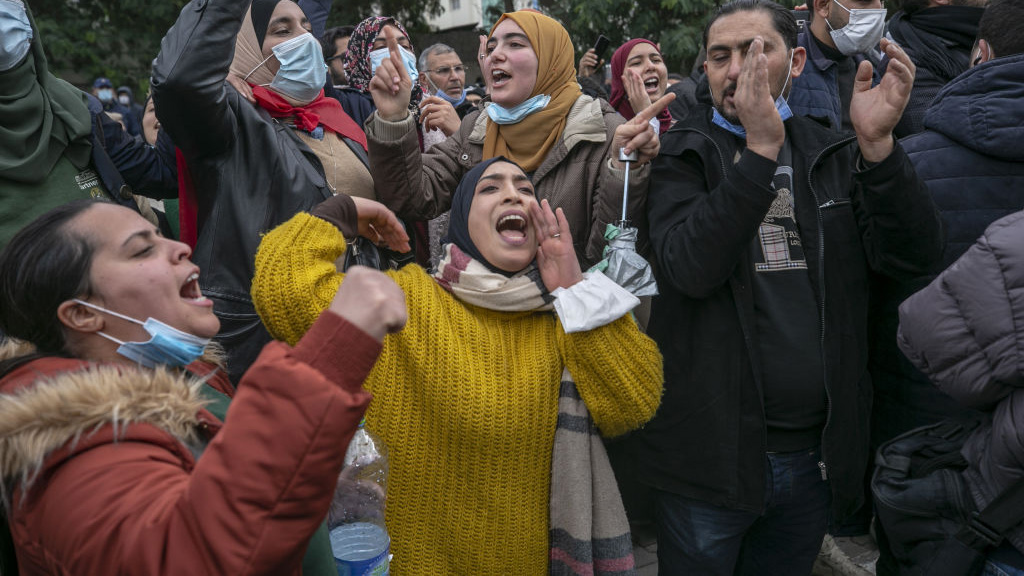
Introduction
Brian Katulis
Vice President for Policy
Look to the people of the region first, then the evolving competition among regional states and global powers, for signs on what to expect.
A look ahead at the drivers likely to shape the Middle East in 2022 finds a complicated array of internal and external forces impacting the people of the region — same as it ever was. What may be different this time is how the internal political dynamics in particular countries intersect with a shifting regional and broader geopolitical landscape.
Three overall areas to monitor in 2022 in the broader Middle East include:
1. How social contracts between the people of the region and their governments might change.
The people of the broader Middle East and North Africa (MENA) make up nearly 10% of the world’s population as it approaches 8 billion. The lives of hundreds of millions of people in this region stretching from Morocco to Pakistan are shaped first and foremost by their immediate surroundings, including overwhelming economic, demographic, and social pressures from within their own societies. The voices of the vast majority of people living in this broad region are often marginalized or completely ignored.
Debate often has a narrow focus on leaders or governments that tend not to fully represent their people’s full range of views. In addition, extremist groups and some retrograde governments hold hostage and expropriate the voices of millions. Across the region on any given day, ordinary people are struggling for basic dignity and freedoms from Sudan to Turkey to Iran. This struggle over the basic social contract will remain a key driver of events in 2022.
The human security challenges identified starting 20 years ago in a series of Arab Human Development Reports are some of the same ones that drove popular revolutions and uprisings across the region beginning more than a decade ago. These conditions are still present at the start of 2022 in most countries, joined by new stresses from the ongoing COVID-19 pandemic and global economic shifts that are impacting different parts of the region in dissimilar ways.
Social contracts between the people and their governments are always subject to renegotiation, with some systems of government giving more voice to the people than others. Afghanistan, Syria, Lebanon, and Yemen are among several countries teetering on the brink of economic and political implosion, as the number of refugees and internally displaced persons (IDPs) remains in the millions, a long-standing crisis that has worsened in recent years as a result of conflict and instability.
In 2022, only a handful of countries like Libya and Lebanon have national elections on the calendar that hold the prospect for some leadership change. But as the past decade of transitions, revolutions, and civil wars has shown, change can come quite unexpectedly and sometimes at quite devastating costs — and rarely with clear progress on human security.
The social contract is not only affected by elections. Even in countries that held elections last year like Iraq and Iran, leaders are scrambling to provide their people answers to unresolved questions about living conditions while power struggles at the elite levels of politics continue. Many of the region’s monarchies are trying to adapt and respond to the concerns of their people and continue to update the economic models in a way that addresses the demands for greater security and prosperity. At the same time, the escalating authoritarian crackdowns in multiple countries across the region and the closing off of basic freedoms demonstrate a lack of confidence among certain governments and leaders about their own standing with their people — brutal repression is a sign of weak leadership in the face of human security challenges.
In 2022 all countries of the region will face added pressures from climate change and rising prices, against a backdrop of uneven economic growth. Extreme heat, sustained drought, and the risks of water and food shortages could add to the burdens of a state system that is already straining from multiple pressures. These drivers will further impact the interplay between governments and their people and broader regional stability.
2. How relationships among key regional actors might shift.
The competition for power and influence among key countries and important non-state actors continues to shape the regional landscape, with many countries operating with a greater degree of independence and assertiveness than in previous eras. These countries continue to test the limits of their power and influence against each other with security and diplomatic moves, and this state competition is complicated by aggressive non-state actors like ISIS and quasi-state actors such as Hezbollah in Lebanon and the Houthis in Yemen.
2021 was a year when countries of the region tested the limits of their power and influence in multiple arenas, including stepped up diplomacy to de-escalate tensions and build new ties — even as conflicts that had regional dimensions such as Syria and Yemen continued. The diplomatic openings and de-escalation through diplomacy along several fault lines in the broader Middle East over the past year could easily be obliterated at a moment’s notice by the attacks and security incidents that happen regularly in the region — a risk underscored by the Houthi drone and missile strikes on the UAE in mid-January.
2022 will be a year when the spotlight will continue to shine on Iran and its relationship with the broader region. Even if diplomacy succeeds in tackling thorny questions related to Iran’s nuclear program, a bevy of broader regional security questions will likely remain unresolved and add to uncertainty across the Middle East.
The trend toward rebuilding relations damaged over the past few years and normalizing ties between countries that had cut them or never had formal relations in the past will likely continue. The rapprochement between Turkey, Egypt, Qatar, Saudi Arabia, and the UAE will move forward slowly, as countries seek ways to coordinate and cooperate on a range of issues such as the economy, energy, and shared security. Yet a certain degree of mistrust and lack of confidence will linger between these countries, and the scars from the wounds of battles fought in the aftermath of the 2011 popular uprisings will endure.
The 2020 normalization accords between Israel and the UAE, Bahrain, Morocco, and Sudan brought certain ties out into the open, but major leaps forward in openings with new countries are unlikely in 2022 without some progress on the Palestinian front.
3. How the shifting geopolitical competition in the world impacts the Middle East.
As a region linking Asia, Africa, and Europe, the broader Middle East remains at the intersection of the competition for influence among global powers. A third driver that will continue to shape the broader Middle East in 2022 is the impact of competition between the U.S., China, Russia, and Europe, as well as emerging powers like India, which has worked to build ties across the region in new ways.
Most countries in the region are already hedging strategically, seeking to maintain good ties with all of these external actors in this wider competition. At the same time, a number of countries in the region such as Israel, Saudi Arabia, and the UAE will likely continue to operate more assertively and independently to pursue their own goals and interests in ways that could produce unpredictable outcomes and discontinuities in the region.
This back-and-forth competition among external powers seeking to impact trends in the Middle East will add another layer of complexity along key fault lines, including Iran and the Gulf, Israel and Palestine, and tensions in North Africa and the Horn of Africa.
The United States will remain involved in the region as the external actor with the broadest and deepest set of ties, but it remains unclear what direction America will seek to take in its broader regional approach given all of the challenges it faces at home and in other parts of the world.
Follow on Twitter: @Katulis
Changing social contracts between the peoples and governments of the region
The MENA region’s myriad human security challenges
Mirette F. Mabrouk
Senior Fellow and Founding Director of the Egypt program
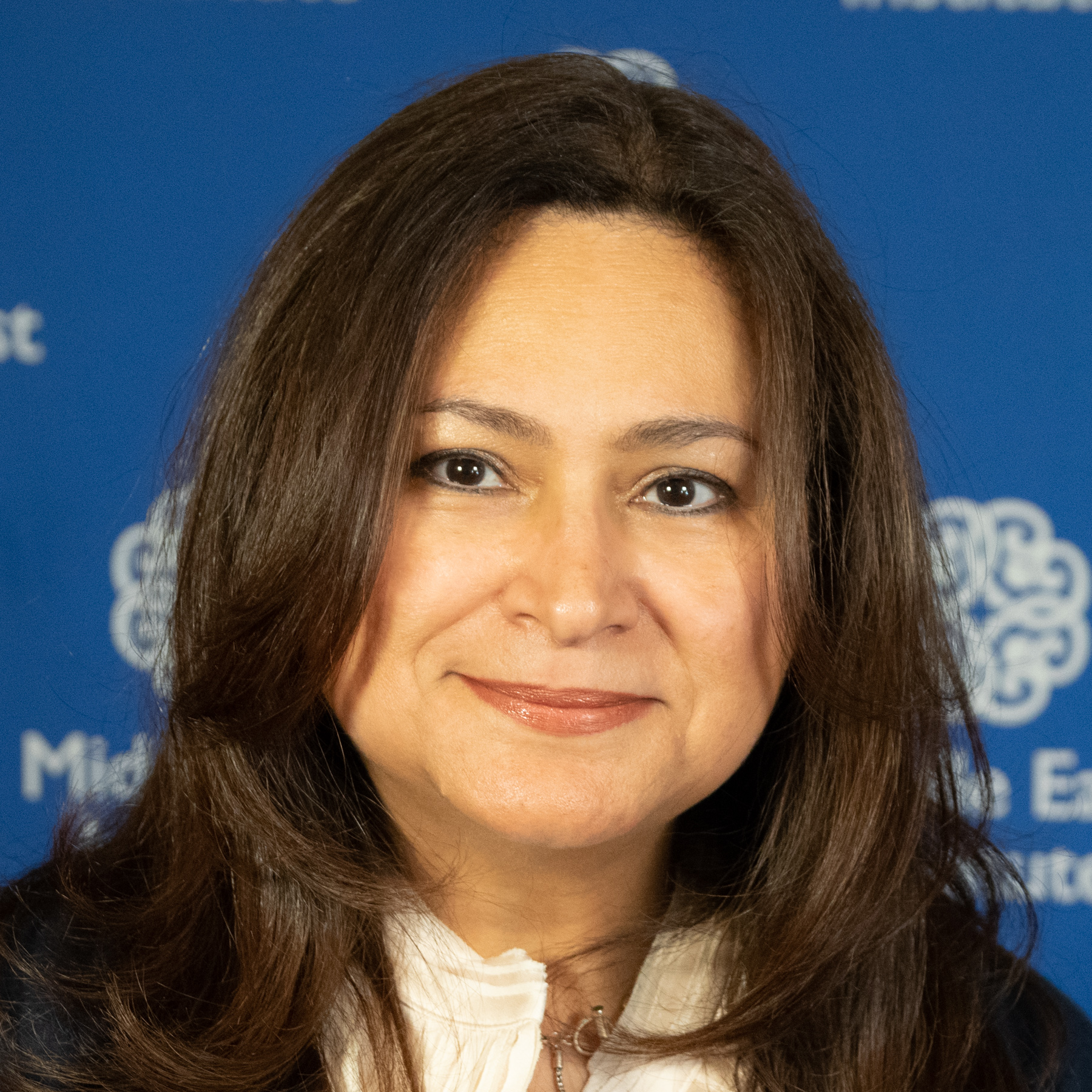
2021 was a year of seesawing challenges for regional governments: the health ravages wrought by COVID, its continued economic fallout, coups (some more successful than others), and saber-rattling in the eastern Mediterranean and along the banks of the Nile.
2022 is unlikely to provide those governments with much relief. If anything, it’s likely to step up the challenges, prompting an expansion of the criteria for what constitutes a security hazard and a closer examination of their abilities to deal with crises and of their relationships with their own citizens.
Formerly, there had existed between the region’s governments and their citizens what was informally termed as “the social contract” whereby governments provided some form of economic and social security in return for the acquiescence of their populace. The Arab Spring tore this contract up and despite the best efforts of regional governments, which have included a mix of economic incentives and civic repression, they have never quite been able to tape it back up. While the need for economic security is still paramount for most citizens, regardless of which government is at the helm, its provision is no longer a guarantee of national torpor. This is partly because many of the region’s governments are still attempting to pursue 20th century solutions to 21st century challenges. Social media, the shifting perceptions and needs of a burgeoning youth population, and a growing global interest in justice and inclusivity (or at least the perception of it) have all necessitated a new means of tackling pressing domestic and international challenges, and governments are struggling to keep up.
It’s an extremely precarious mix. Fail to provide jobs and security, and your citizens may revolt. However, if one’s most basic needs are met, one is more likely to question and criticize governance.
COVID has only exacerbated the myriad challenges. The pandemic will continue to wreak havoc on strained health services across the region. Vaccine inequity is only likely to rise, particularly among poorer countries. While citizens of developed economies are likely to have had their third booster shots, emerging economies are likely to be struggling to provide a second shot and almost 30% of those with conflicts have only provided a first. There are glimmers of hope, however. The region might no longer have to rely as desperately on Western vaccine handouts thanks to the possibility of regionally produced ones; Egypt, for example, is currently in the first stage of clinical trials for its own vaccine.
Other challenges include the ability of governments to adapt to, and mitigate, climate change hazards. Rising heat levels are a direct threat to agriculture and agrarian economies face a slow, inexorable creep to the cities, with all the accompanying dangers of urbanization. That’s likely to exacerbate an issue caused by one of the region’s biggest challenges, its burgeoning population growth. MENA has had the world’s highest youth unemployment for over a quarter of a century and that goes double (almost literally) for women. Youth unemployment in North Africa stands at around 29.3%, and at 22.2% in the Arab states, but for women, those figures shoot up to 40.3% and 36.5% respectively. It’s even worse for those with disabilities.
International disagreements over transboundary natural resources, terrorism, and heightened global competition for a piece of the economic pie all present challenges too. However, it is becoming increasingly urgent for governments and citizens to take stock of each other. Clearly there isn’t a one-size-fits-all solution and some countries boast significantly higher levels of national satisfaction with governance than others. In those that don’t, the goal should be long-term sustainability, rather than short-term stability.
Follow on Twitter: @mmabrouk
Across North Africa, parallel domestic challenges but differing trajectories
Intissar Fakir
Senior Fellow and Director of Program on North Africa and the Sahel
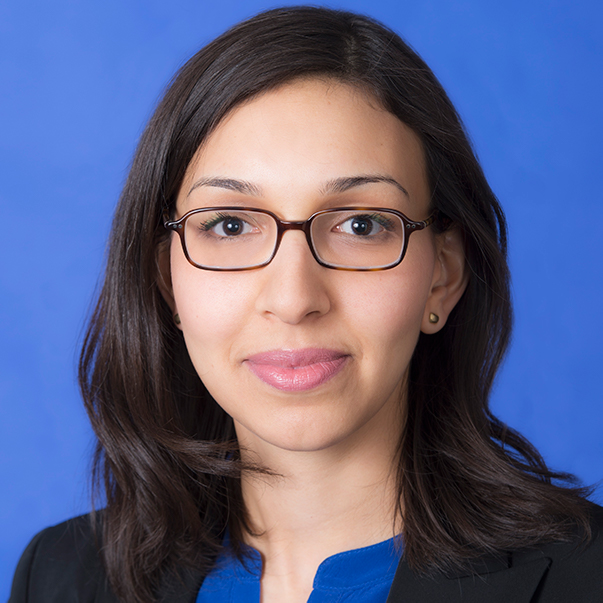
North African countries face significant political, economic, and security challenges in 2022 and they do so amid persisting intraregional distrust and shifting geopolitical dynamics. The U.S. and Europe’s influence is waning while the Gulf states, Turkey, China, and Russia have been inserting themselves into influential niche positions across the region.
As one of the least economically and politically integrated regions of the world, North Africa will continue to lack the ability to respond to collective challenges of regional instability and insecurity. This lack of unity allows individual regional and international actors to pursue their diplomatic, military, and economic interests unilaterally and at times promotes unhealthy competition. On the domestic level, heterogeneous trajectories will continue to play out, requiring individual attention for each country and overshadowing parallel domestic challenges.
Morocco and Algeria will likely continue their zero-sum approach to maximizing their influence across North Africa, the Sahel, and the rest of the African continent. This division among key regional actors encourages divergent foreign policies that could place them further at odds. For countries in crisis like Libya and Tunisia, regional support will remain minimal and leaders in both countries will look to Europe or the Gulf for assistance rather than their neighbors. Tunisia faces a crushing economic crisis and an autocratic regression that require resources and support beyond what regional actors are willing or capable of offering. Libya’s ongoing political and security crisis, which has drawn an unprecedented level of foreign military involvement in North Africa, will continue to be negotiated in Europe, Turkey, and the Gulf, rather than among regional actors.
The primary threat to stability in Morocco, Algeria, and Tunisia remains structurally weak economies made more vulnerable by the pandemic, low energy prices, and poor governance. The key challenge for Morocco this year is managing the social vulnerabilities the pandemic exacerbated. Morocco went into the pandemic with strong and effective policy responses, yet with an uneven economic recovery the country may struggle to deliver on lofty social promises. Amid rising prices, food shortages, and low vaccination rates, the Algerian government will continue to be at mercy of its hydrocarbon sector. In Tunisia, the impending constitutional revisions and elections promised by President Kais Saied are unlikely to put the country decisively back on a democratic path. But the more relevant question is whether these reforms will take place within an easier economic climate. Tunisia’s economic challenges remain daunting, and President Saied’s single-handed control of state institutions has not yet allowed for easier or more decisive management of the economy. While Libya’s political process continues to be negotiated globally, local challenges such as access to resources, food, and public services could worsen if a political process remains elusive and the specter of conflict increases.
Follow on Twitter: @IntissarFakir
Afghanistan heads into another difficult year
Marvin G. Weinbaum
Director, Afghanistan and Pakistan Studies

The new year is destined to be bleak for Afghanistan: Its economy is in freefall, half of its population is malnourished, and delivery of desperately needed foreign humanitarian aid amid the COVID-19 pandemic is expected to be slow and inadequate. The country’s financial crisis was inevitable. Afghanistan’s international benefactors cut off virtually all forms of assistance following the Taliban’s seizure of power in August 2021. International banks suspended loan payments, and the U.S. Treasury froze $7 billion of the more than $9.5 billion in Afghan state bank reserves held abroad. As much as three-quarters of the previous regime’s budget and roughly 45% of its GNP had been covered by foreign assistance. Starved of cash, the Taliban government is unable to pay civil servants and healthcare workers. Looking ahead, finding the funds to rebuild the financial system and cope with the growing humanitarian crisis constitutes the biggest challenge for the fledgling Afghan state.
The Taliban begin the new year having consolidated power but struggling to govern. What worked for them on the battlefield did not prepare them for ruling a country far different than the one they yielded more than two decades ago. Present-day, drought-plagued Afghanistan is a more populous and diverse country whose various interests the Taliban government seems unable or unwilling to accommodate, and whose expectations of government were raised by years of the largesse generated by the Afghan war. The Taliban bureaucracy, decimated by the firing or flight of civil servants, is ill-equipped to deliver even the most basic services without the help of international agencies and non-governmental organizations. Little of this is likely to change in 2022.
After six months in power, the Taliban regime continues to be denied full diplomatic recognition by regional powers and the rest of the international community. All have claimed to be waiting to assess the government’s behavior in office, and countries have tried to use recognition as leverage to induce the Taliban leadership to form a more inclusive government and soften their social policies. Yet, despite the Taliban’s resistance of these pressures, most countries have elected to engage regularly with the Kabul government, in effect granting it political legitimacy. While the U.S. and European countries will likely delay, nearly all regional powers, with China and Pakistan in the lead, can be expected to reopen their embassies in Kabul in the coming months.
Post-war Afghanistan, although considerably more peaceful, is not conflict free. The high-profile, often-ruthless attacks by Islamic State-Khorasan Province against the Afghan government and civilians, in particular the Shiite minority, seem certain to continue. Revenge killings against security forces personnel and others closely aligned with the defeated regime are likely to stretch well into the new year. Civil unrest seems likely to intensify with economic hardship and will be met with violent suppression by an increasingly repressive Taliban regime. Clashes between Taliban forces and the Pakistan military over border fencing may continue, and armed intervention by a neighboring state cannot be ruled out if the Kabul government allows militant groups encamped on Afghan soil to export insurgency.
Follow on Twitter: @mgweinbaum
The Palestinian Authority’s accelerating legitimacy crisis
Dana El Kurd
Non-resident Scholar
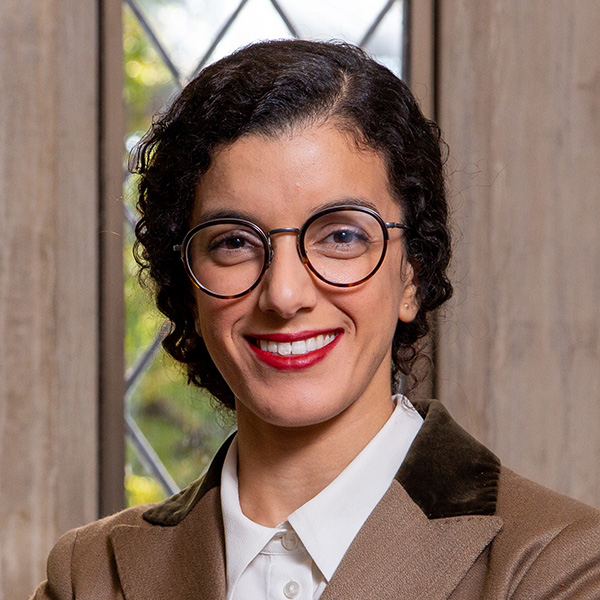
2021 in Palestine saw unprecedented developments in grassroots mobilization and protest, particularly with the events of what was later termed the “Unity Intifada.” Palestinians under every form of Israeli control — inside and outside the Green Line — mobilized against ongoing repression of their co-nationalists in Jerusalem, as well as in support of armed resistance from Gaza. The Unity Intifada events were highly significant, not only because they mobilized diverse groups of Palestinians for the first since the Second Intifada 20 years ago, but also because they allowed activists to build an organizational infrastructure that continues to play a significant role in Palestinian politics today. In comparison, the Palestinian Authority (PA) was notoriously absent from even playing an advocacy role on behalf of Palestinians in Gaza, facing one of the worst assaults since the 2008 war, and on behalf of Palestinians in Jerusalem facing imminent expulsion.
The same sets of organizations and activists that gained experience in coordinating the Unity Intifada were responsible for facilitating the large-scale protests that erupted against the PA, following the killing of an activist in Palestinian police custody. Palestinians in the West Bank are a more thoroughly demobilized population than their compatriots in other parts of historic Palestine; as such, these anti-PA protests were particularly significant, in both size and impact. The PA responded by attempting to crack down on protesters, sending plainclothes policemen and Fatah party members armed with clubs and makeshift weapons intended for street battles. The PA also drew outrage during this time over its use of gendered violence against female protesters and journalists.
Moreover, there was the scandal of the elections. After receiving no assurances from the Biden administration that the results would be respected, and recognizing how little popularity Fatah actually had, PA President Mahmoud Abbas cancelled the legislative and presidential elections scheduled for 2021, deeply frustrating the Palestinian public — a majority of whom supported the elections (according to polling by the Palestinian Center for Policy and Survey Research) and were eager to participate in decision-making for the first time since 2006. Cancelling the elections thus fueled more organizing around alternatives to the PA. This included initiatives in the occupied territories such as the New Democratic Generation’s representative youth body (Jeel al-Tajdeed al Democrati), as well as initiatives in the diaspora such as Masar Badil (which argues that the Palestine Liberation Organization is a corrupt institution, and the only way forward for Palestine is a “revolutionary path” focused on resistance).
Finally, the PA’s infrastructural decay also came into stark relief over the past year, as it struggled to cope with the COVID-19 pandemic — and in fact exacerbated public tensions with its inequitable vaccine distribution. The PA also repeatedly drew outrage over what many see as rampant signs of corruption; for instance, a recent meeting between President Abbas and Israeli Defense Minister Benny Gantz angered Palestinians when it came to light that one of the points of discussion was VIP permits for PA officials. Palestinian media also reported on nepotism within the PA, when for example the daughter of a PA ambassador was appointed to take her father’s position as if by hereditary succession.
As Palestinian policy analysts Fadi Quran and Tahani Mustafa put it, the PA is “now becoming increasingly exposed as ineffective, overly reliant on the securitization of daily life, and excessively dependent on international aid, counting on the public to shoulder the burdens it faces.” This state of affairs bodes poorly for the future of the PA and its institutions. As outlined above, the PA has faced huge setbacks in legitimacy, in addition to weakening infrastructural power and ability to provide social services as a result of Israeli politics, as well as its own incompetence. While the events of 2021 did not initiate these trends, they rapidly accelerated the legitimacy crisis facing the PA today. It is highly unlikely that the PA can reverse course. This means that Palestinians (and policy-makers that monitor the situation in Palestine) can expect an increase in instability and all that it breeds — including greater use of violence — in the future.
Setbacks for democratization and a steady erosion of human rights
Charles W. Dunne
Non-Resident Scholar
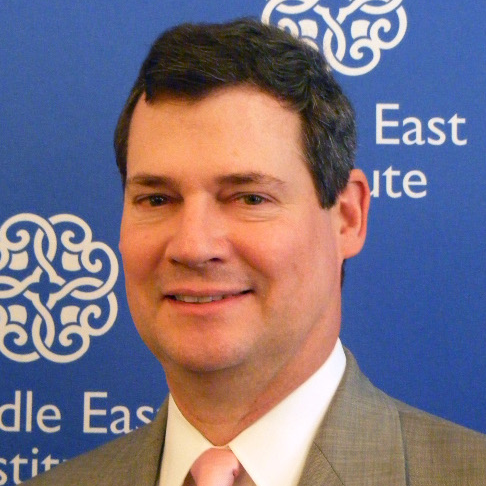
Ten years after the Arab Spring upended the established order in MENA, broaching the promise of greater political freedoms and respect for human rights, authoritarian powers in the region appear stronger than ever. Prospects for democratization have suffered a series of setbacks, while global leadership on democracy and human rights, particularly that of the United States, has stumbled. These trends show little sign of abating in 2022, with troubling implications for the MENA region.
Over the last two years autocratic governments took full advantage of the COVID-19 pandemic to expand their authorities and crack down on activists, doing long-term damage to political and personal rights. Harsh new restrictions on public gatherings and political expression were imposed in a number of countries under cover of public health imperatives, such as Egypt and Algeria; Jordan and Morocco likewise used measures passed to combat the coronavirus to arrest and intimidate demonstrators and activists. As 2021 gave way to the new year, these strictures, portrayed as temporary “emergency” powers, show no signs of disappearing and are expected to remain on the books long after the pandemic recedes.
Last year also saw alarming setbacks in two countries that seemed to be breaking from the authoritarian past. Tunisia, the lone democracy to emerge from the 2011 uprisings, regressed substantially after President Kais Saied suspended the parliament on July 25 and announced he would temporarily rule by decree. Sudan’s hoped-for transition to civilian rule was thrown into chaos on Oct. 25, when military chief Gen. Abdel-Fattah Burhan seized power and dissolved the civilian cabinet, and the situation remains highly unstable. These reversals were at least tacitly supported by leading authoritarian governments in the Middle East, including Egypt, Saudi Arabia, and the UAE, as part of a forward-looking strategy to discourage or reverse democratic gains throughout the region and head off domestic challenges of their own.
The steady erosion of human rights and political freedoms in the region was due not just to increasingly sophisticated strategies employed by autocratic regimes, but by erosion of democratic norms globally, which allowed authoritarian rulers more breathing room. In particular, the increasingly bitter politics and challenges to democratic norms in the United States hindered Washington’s ability to serve as an effective tribune for global democracy. The extension of Russian and Chinese influence in the region — including arms sales and economic deals — without the human rights baggage that often comes with close ties to Washington provided a sense of allyship for many regional governments on issues of governance and human rights.
The Biden administration pledged to place human rights and democracy at the forefront of its foreign policy, but largely took a pass when it came to the Middle East. While pledging closer scrutiny of arms sales to human rights abusers in the region, the administration nevertheless proceeded on major arms deal with Egypt, Saudi Arabia, and the UAE. President Joe Biden’s promise to hold Saudi Arabia accountable for the murder of U.S.-based journalist Jamal Khashoggi resulted in visa bans for 76 Saudi nationals, but no sanctions against Crown Prince Mohammed bin Salman, who the U.S. intelligence community believes ordered the killing. Biden’s touted Summit for Democracy in December 2021 largely avoided dealing with the Middle East at all.
In 2022 citizens’ demands throughout the MENA region for greater personal and political rights are likely to intensify, leading to more, and perhaps more violent, showdowns with governments. One question is whether Western and particularly U.S. leadership will be able to respond effectively.
Raisi’s path to succeed Khamenei looks increasingly rocky
Alex Vatanka
Director of Iran Program and Senior Fellow, Frontier Europe Initiative
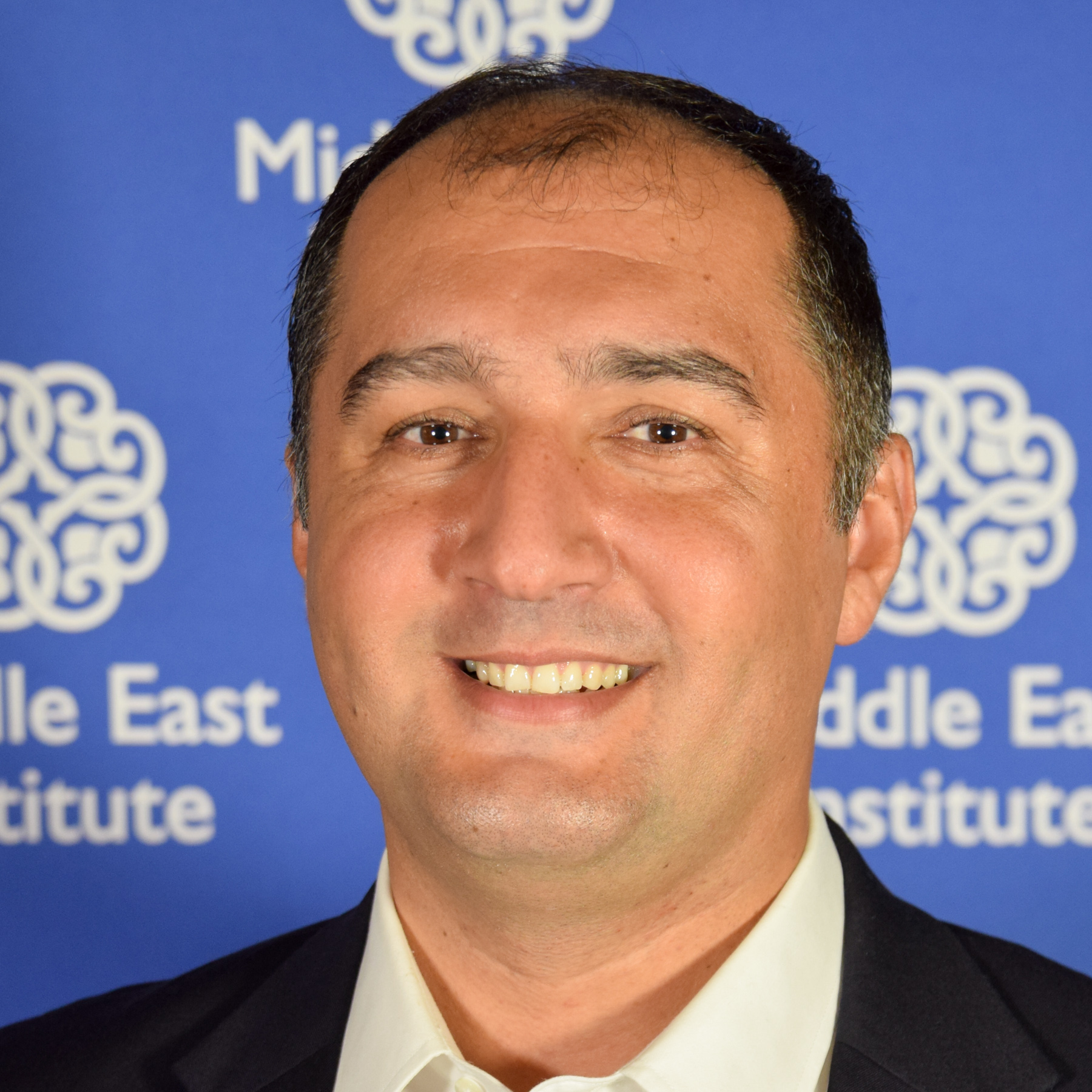
In 2021, Iranian Supreme Leader Ayatollah Ali Khamenei made sure Ebrahim Raisi was installed as president. At the time, the logic seemed simple: The 82-year-old Khamenei wanted Raisi to be his successor and was paving the way for him. Khamenei’s death would represent the biggest political transition in the Islamic Republic since Khamenei himself took over the job from Ruhollah Khomeini in 1989. But not much in Raisi’s first six months in office as president suggests that Khamenei is willing or able to do much more to elevate Raisi’s standing in society.
First, Raisi lacks and is unlikely to ever have a political vision that he can call his own. As a leader, he is struggling even as a public speaker and his legitimacy is highly contentious. Even some of his own supporters are raising the alarm that not only is he performing poorly as president, but he is hurting the entire hardline camp.
Moreover, Raisi lacks a clear policy agenda. The presidency of Akbar Hashemi Rafsanjani (1989-97) was about economic reconstruction; Mohammad Khatami (1997-2005) the renewal of civil society; Mahmoud Ahmadinejad (2005-13) wealth redistribution and meeting the needs of the poor; and Hassan Rouhani (2013-21) ending Iran’s international isolation. Rafsanjani, Khatami, Ahmadinejad, and Rouhani each only had partial success in delivering on their promises, but at least they articulated what they wanted to achieve. Not only has Raisi failed to do the same, so far he has also proven unable to unify the hardline factions.
When he became president, Raisi said his government would be “non-partisan.” This turned out to be untrue as almost all his key appointments have come from various hardline factions. But Raisi has failed to bring these factions together. This has been particularly evident in the government’s economic policy-making, one area that Raisi can shape far more than the nuclear issue, which is basically under the control of Khamenei and the Islamic Revolutionary Guard Corps.
When Mohsen Rezaei, Raisi’s vice president for economic affairs, recently said that cash handouts to the poor would be doubled, the minister of finance, Ehsan Khondoozi, publicly contradicted him and rejected the suggestion. To the Iranian public, the upshot of this open disagreement was clear: The Raisi government is even failing to coordinate its policy on something as simple as welfare for the poor. The incident also suggests the Raisi government is far more fragmented than meets the eye.
A nuclear deal in Vienna, and the lifting of some of the sanctions that come with it, will lessen the pressure on Raisi. But his challenges are deeper than the state of the economy, and his much-touted eventual transition from the presidency to the supreme leadership will likely come under far closer scrutiny in 2022.
Follow on Twitter: @AlexVatanka
Which Libyan-led process will lead to elections in 2022?
Jonathan M. Winer
Non-Resident Scholar
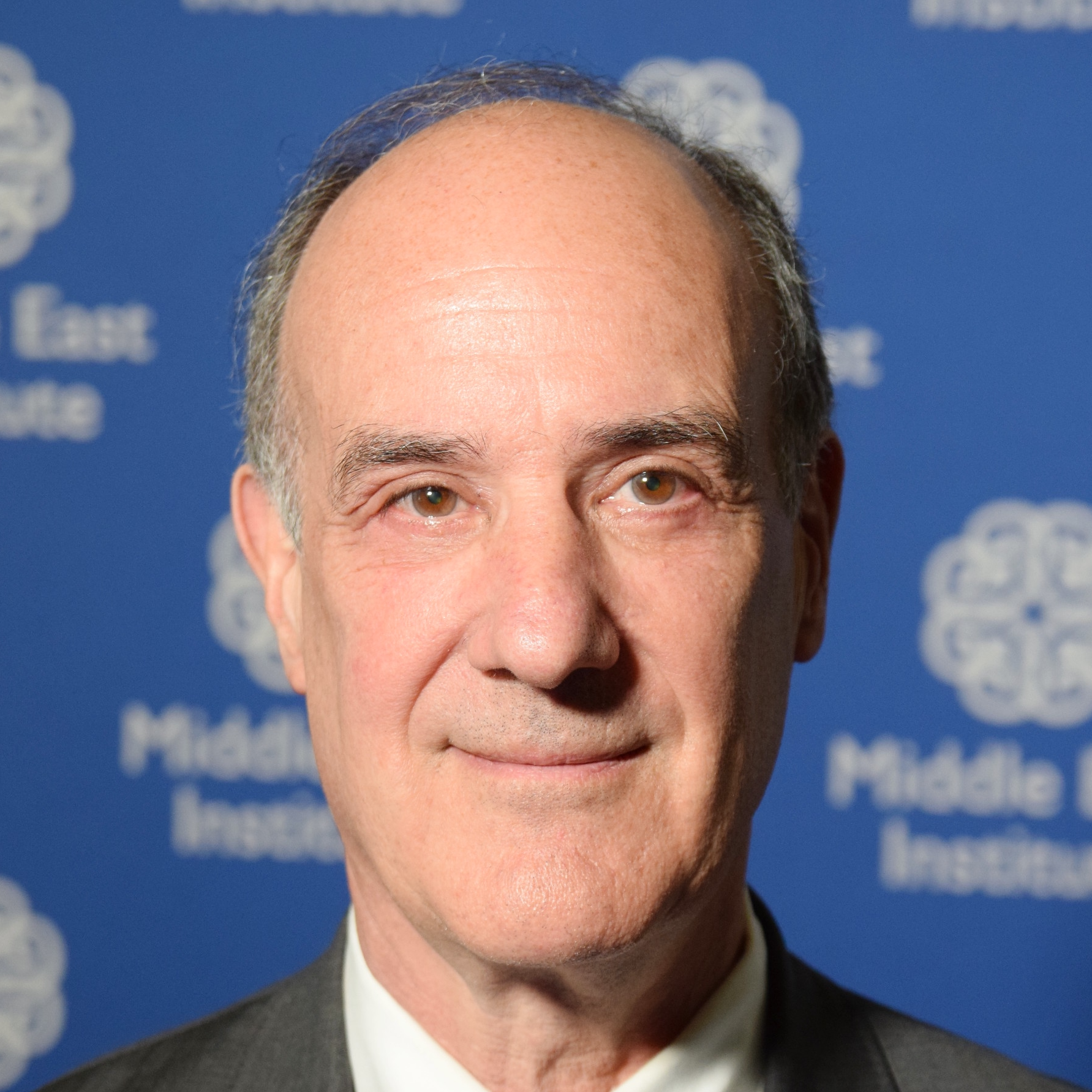
Since the late December collapse of the promised Dec. 24, 2021 elections in Libya, the recently-appointed special advisor to the U.N. secretary-general, Stephanie Williams, has undertaken the mission of finding a path forward to restart and fulfill the process of electing a Libyan president and parliament by June.
Williams has undertaken a flurry of January meetings with foreign actors, traveling to Cairo and Ankara to meet with Egyptian and Turkish leaders, and is on her way to do the same in Russia. These followed her late December efforts to corral Libya’s own power-brokers, including Prime Minister Abdul Hamid Dbeibah, warlord Khalifa Hifter, and former Interior Minister Fathi Bashagha, into supporting the election process regardless of what happened next.
Meanwhile, the Tobruk-based House of Representatives (HoR) and the Tripoli-based High State Council (HSC) have continued their efforts, originally announced on Jan. 2, to create a new election roadmap of their own based on consultations with other Libyan bodies. Success in this would constitute a true Libyan-led process, initiated and chaired by Libyans, rather than by the U.N. But based on past performance, there are substantial grounds for skepticism that the dinosaurs actually want to see free and fair elections that could lead to their own extinction.
These include the head of Libya’s HoR, Aguila Saleh Issa, who on Jan. 17 again took up his position of speaker, from which he had resigned to run for president. On doing so, he immediately convened the HoR to announce that the Dbeibah government’s mandate had expired, and called on the Central Bank of Libya to halt all government spending until such time (if any) as it was approved by the Finance Committee of the HoR. Such chaos-inducing behavior was a major factor ensuring the ineffectiveness of the prior U.N.-facilitated Government of National Accord that was succeeded by Dbeibah last year.
For his part, the patronage-savvy Dbeibah, selected through the Libyan Political Dialogue Forum (LPDF) process shepherded by Williams last year, maintains good reason not to fall in line with the HoR-HSC initiative aimed at depriving him of his position. Dbeibah might be happier to see the LPDF reconvene and, as the 75-person body that elected him, either develop rules enabling him to run for president and win, or at the least, create a process that competes with the HoR-HSC one so that nothing happens.
A minimum pre-requisite for any election process, “Libyan-led” or otherwise, to succeed, is to have the internationals align. Currently, Egypt, Russia, and Turkey face major issues with greater political salience to their domestic constituencies than the future of Libya. The desire of international actors to see Libya no longer create unpredictable political and security risks for others may be the one factor most likely to help Williams secure some form of success in 2022.
After Abbas: The complexities of Palestinian succession
Khaled Elgindy
Senior Fellow, Director of Program on Palestine and Palestinian-Israeli Affairs
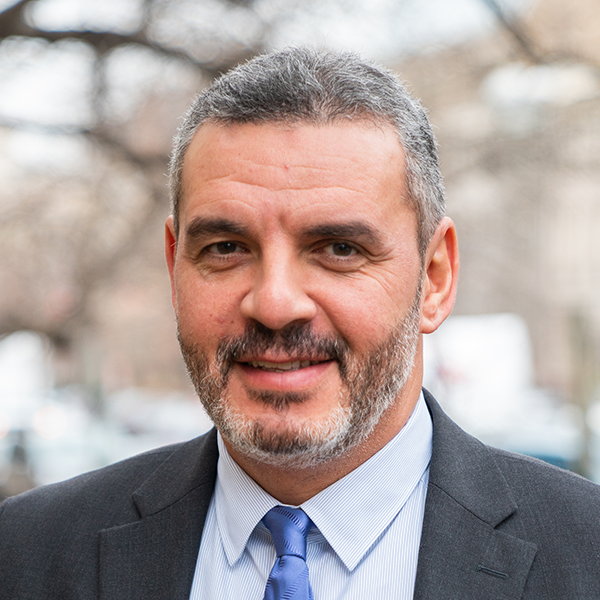
A year ago at this time Palestinians were preparing to hold their first elections in 15 years. Those elections were eventually cancelled by President Mahmoud Abbas at the last moment. Had they taken place, however, the elections would have been a major step toward reviving Palestinian institutions and political life, both of which have been stagnant for many years. Although new elections are not yet on the horizon, Palestinians could still see some sort of political transition in the near future in light of President Abbas’s advanced age (he turns 87 later this year) and declining health.
Any Palestinian succession process is likely to be messy and even crisis-ridden. Unlike like the last succession process in 2004, when Abbas was the clear and obvious choice to succeed Yasser Arafat, Abbas has no heir apparent. Indeed, Abbas has effectively worked to prevent such an outcome by actively purging or sidelining any and all potential rivals. Moreover, Palestinians are looking at not one succession process but three. Abbas, who currently heads Fatah, the Palestinian Authority (PA), and the Palestine Liberation Organization (PLO), is likely to be the last Palestinian leader to wear all three hats at once. Thus, for the first time since the PA’s creation in 1994, the PA president, who is popularly elected and oversees the affairs of Palestinians in the West Bank and Gaza, is likely to be different than the chairman of the PLO, who is to be named by the group’s Executive Committee and (at least theoretically) represents Palestinians worldwide.
In any event, Abbas’s departure is likely to trigger a power struggle — first within Fatah itself, and then eventually (or perhaps simultaneously) between Fatah and its chief political rival, Hamas. There are currently several factions inside Fatah, many of which emerged in direct opposition to Abbas’s leadership. While the likelihood of protracted infighting among party’s notoriously fractious ranks remains high, it is not inconceivable that anti-Abbas factions, most notably that of the now excommunicated former Gaza security chief Mohammed Dahlan, would be reabsorbed into a new, more unified Fatah. Whether a succession process would make Fatah-Hamas reconciliation more or less likely is also unclear. Regardless, although Hamas is not officially part of the PLO, its involvement and consent in naming a new PLO chair will be critical to the legitimacy of the process.
That said, one Palestinian figure stands out as a potential unifying force in a post-Abbas era; Marwan Barghouti, the Fatah commander currently serving multiple life sentences in an Israeli jail, remains hugely popular at the grassroots level, as well as within Fatah, and is widely respected among Hamas and other opposition cadres. While Barghouti’s imprisonment would certainly hamper his ability to govern or lead effectively, it would also have great symbolic value for Palestinians and the international community.
Exactly how Abbas’s departure might affect Israel or the potential for a diplomatic process also remains unclear. The Israelis in particular would have a hard time resisting the urge to try to shape the outcome, although such efforts would almost certainly backfire. Regardless of how or when the succession process unfolds, the next Palestinian leader — or leaders — are likely to be far less accommodating of U.S. and Israeli demands than Abbas.
Follow on Twitter: @elgindy_
A changing regional landscape and shifting relationships among key actors
MENA economic outlook: Divergence and uneven growth
Karen E. Young
Senior Fellow and Director of Program on Economics and Energy

In the economic outlook for the region in 2022, there are some substantial headwinds. While there is some relief at the rebound of oil prices for producers, this comes as a double-edged sword in the region, as we see rising prices across goods and services, commodities, and especially food.
For oil and gas importers, this creates additional barriers to economic growth and imposes a greater burden on lower-income households in terms of the cost of living. Consumer price index growth is expected to be about 5.8% in 2022, which is substantial, but a reprieve from the 11.3% growth experienced in 2021, according to estimates by IHS Markit. So, while the average GDP growth expectation is favorable — the IMF estimates regional GDP growth in 2022 at just over 4% — there are wide variations across countries in growth expectations. Those expected to achieve very high growth rates, like Iraq, are coming from a major contraction, so the rate of change in economic activity is less important than the actual expectation of new investment and possible job growth.
The unevenness of economic growth is related to the differences in sources of revenue, especially for oil and gas exporters, but also in government fiscal capacity. Some governments are simply in a more difficult position to access capital, whether in the form of direct financial support or new loans. Many MENA states now regularly depend on injections of capital, as central bank deposits or commitments of foreign direct investment, from the Gulf states. This is a problem because unlike a finance agreement from the IMF, there is no regular schedule to Gulf support. It is more volatile and commitments of investment are not equal to cash in hand. An oil price boom can strengthen Gulf reserves, but their own financing needs and new infrastructure and clean energy commitments at home will be prioritized first.
Turkey's financial distress is one prime example where Gulf state support would be welcomed, but has not arrived in the form of a central bank deposit, which is most needed to help defend the value of the lira. Instead, we see UAE interest in buying up reduced price assets. Qatar has committed to a currency swap line, as has the UAE, but these too are less than Turkey probably desires.
Jordan is also now reliant on an IMF package (with $400 million in an Extended Finance Facility) and a new $1 billion Eurobond debt issuance to help with its external financing needs in 2022. The COVID-19 pandemic continues to influence the ability of MENA states to garner tourism foreign exchange revenue, and Jordan will be sensitive to any variant disruptions this spring and summer. And while the Jordanian current account deficit will narrow in 2022, the country will continue to face a constant need for external finance, including direct financial support from the Gulf states.
In Egypt we see another headwind related to global borrowing costs, as its vibrant portfolio investment destination is threatened by a rise in interest rates in the United States, which may create some pressure for capital to exit emerging markets once advanced economies raise their rates. Central banks in the region, and especially in Egypt, will be watching closely to manage inflation and exchange rates. Egypt also recently raised the price of subsidized cooking oil and local fuel in October 2021, adding to existing consumer price pressures. Price control management will continue to constrain fiscal policy and is a pressure point in domestic politics. And like Jordan, tourism inflows will be vulnerable to continued pandemic variants.
The outlook then is that inflationary pressures are hurting everyday citizens and consumers, while governments flush with new oil receipts will be focused on spending at home and targeted acquisitions abroad. If interest rates start to go up, the cost of capital will increase for those countries with persistent fiscal deficits. And those MENA economies that have enjoyed strong portfolio inflows may see a risk of capital flight to advanced economies. For MENA economies already in crisis, 2022 could be a difficult year for restructuring debt and accessing new sources of support, especially for Lebanon and Iraq. For Yemen, price pressure will do its worst on the humanitarian situation and food poverty.
In some good news, vaccination across the region has seen some success, though again the variation within the region is striking. Bahrain, Israel, Saudi Arabia, and the UAE have been leaders in vaccination roll-outs, while Algeria, Egypt, Iraq, Lebanon, Syria, and especially Yemen, are far behind. 2022 will continue the trend of disaggregation of MENA economies. The new year also brings opportunity for policy innovation, demonstrating government service delivery and creative ways to better target citizens most in need.
Follow on Twitter: @ProfessorKaren
Climate action takes center stage, but water security issues may steal the spotlight
Mohammed Mahmoud
Senior Fellow and Director of the Climate and Water Program

The MENA region will host two climate meetings this year that will allow the region to play a leadership role in influencing climate action and policy at the regional and global scale. First is the inaugural Middle East and North Africa Climate Week, to be held in Dubai from Feb. 28 to March 3. This United Nations-supported event will seek to build collaboration within the region to explore solutions and opportunities for the current and future climate challenges facing this part of the world.
Later this year, the Conference of the Parties (COP) comes to North Africa, when Egypt hosts COP27 in Sharm el-Sheikh during the month of November. This year’s COP meeting will likely push the theme of climate adaptation to the forefront, considering Egypt’s role as co-founder of the Adaptation Action Coalition. This provides an opportunity for Egypt to take the lead in making significant progress in the area of climate adaptation, following the failure to do so at COP26 in Glasgow with respect to climate mitigation (and emission reductions). With the COP remaining in the Middle East next year — COP28 will be in the UAE — the momentum of this year’s meeting can be carried forward into 2023 with a sense of continuity under the shared guidance of its regional hosts.
However, the enthusiasm for the Middle East’s upcoming role in climate action is tempered by the lingering and worsening state of water security issues in the region. Sustained drought conditions are causing countries in the Middle East to near a dangerous tipping point with respect to water scarcity that will manifest larger and broader complications beyond just water shortages. The dire consequences of diminished water supplies seen last year in Turkey, Jordan, Syria, Lebanon, Iraq, and Iran could get even worse if adequate access to clean and affordable water is denied to human, agricultural, and industrial users.
We could be on the cusp of a serious humanitarian crisis due to the cascading outcomes of water shortages brought about by prolonged drought. Water rationing impacts the amount of water available for human consumption and agricultural production, driving up the cost of food and alternative sources of water. Economically-challenged communities will find it difficult to afford enough food and water to meet their needs, increasing the potential of famine and/or an outbreak of water-borne illnesses if desperate communities look to consume unsafe untreated water from local tributaries and groundwater wells.
The region’s ongoing refugee and IDP crisis faces rising donor fatigue
Robert S. Ford
Senior Fellow
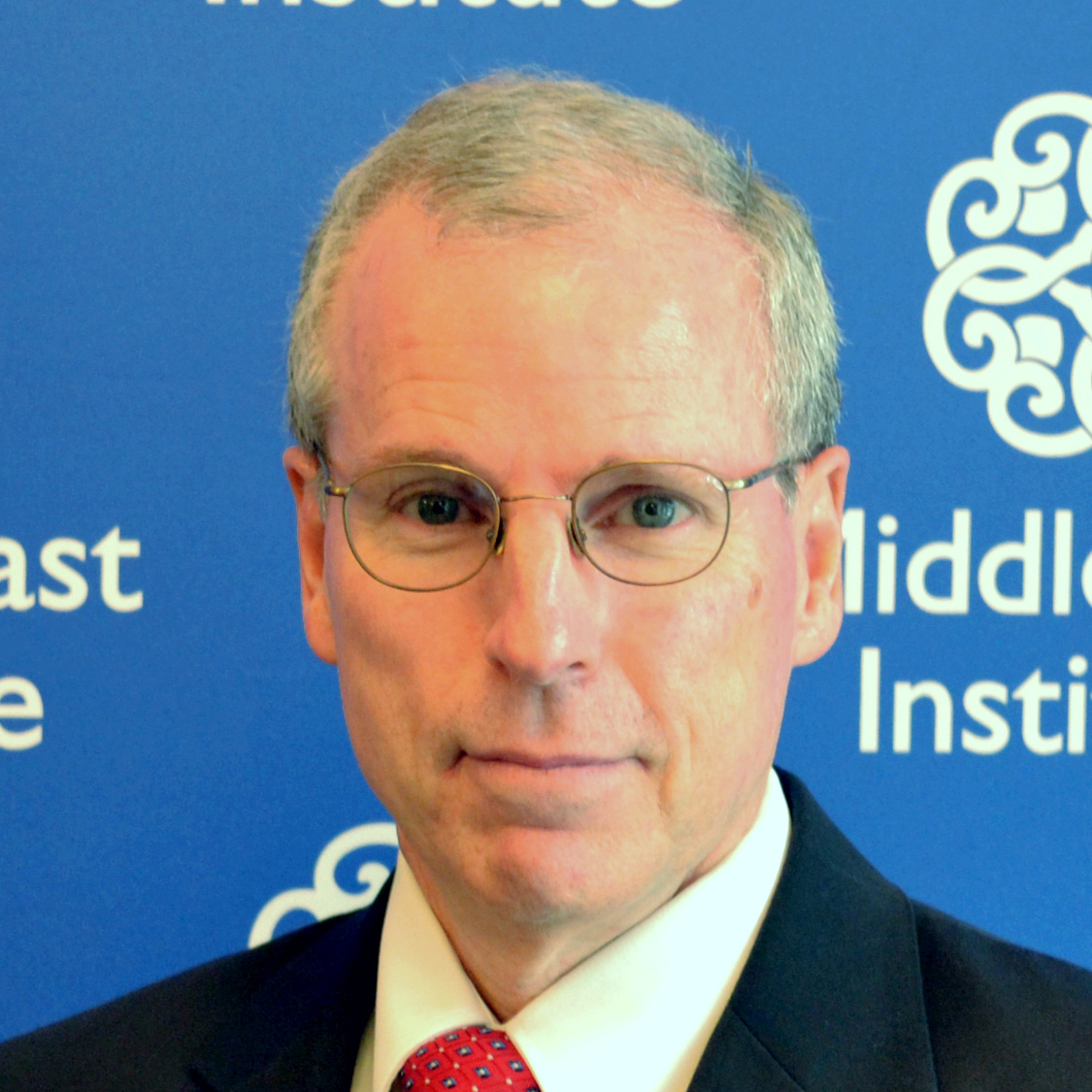
The situation of 13 million forcibly displaced Syrians, the most acute refugee and IDP crisis in the region, will not ease much in the next year. Among the 6 million Syrian refugees, few are willing to return to their homes as long as the unrepentant Syrian government still rules the country. Syrian refugees in Lebanon, however, face particularly difficult circumstances; the U.N. estimates over 90% are in extreme poverty. Across the border inside Syria, conditions for the 7 million internally displaced will remain difficult. Syria’s economic crisis, the COVID-19 pandemic, and rampant insecurity will be sustained problems. Two additional problems will hinder efforts to address IDP needs in the new year as well. First, donor fatigue is limiting the ability of the U.N. and its partners to help Syrian IDPs. Notably, the 2021 U.N. Humanitarian Response Plan was only 46% funded. In addition, Russia probably will again press to close off cross-border aid from Turkey into northwest Syria in July 2022 and replace it entirely with humanitarian aid shipments from government-controlled territories. This so-called cross-line assistance was small in 2021, and it is not clear whether logistically it can be ramped up quickly in the second half of 2022 or whether the Syrian government would even allow that.
The U.N. also estimates there are 4 million Yemeni IDPs, the fourth-largest IDP population in the world. Fighting forced another 67,000 to flee their homes during 2021, and continued fighting in 2022 will likely add to the number while insecurity and the shattered economy will impede their return. The U.N. also has funding difficulties in Yemen; a January 2022 report noted only 3% of its $291 million request for 2021 was funded. As a result, only a fraction of Yemeni IDPs were getting assistance.
Meanwhile, 1 million Iraqi IDPs still cannot go home in the wake of the battle against ISIS and ongoing tribal disputes, threats from local militias, and antagonism toward IDPs from local authorities. The Iraqi government may follow its November 2021 closing of the biggest formal IDP camp in western Iraq with more formal camp closures, aggravating the situation of displaced persons in that region. The vast majority of Iraqi IDP camps are in Iraqi Kurdistan and the sharp economic downturn there will increase pressure on the Iraqi Kurdistan government to reduce support. The U.N. and its partners providing aid to Iraqi IDPs also will face further donor fatigue; only 55% of their funding requests were met in 2021.
Facing economic misery and with few prospects for returning home, more refugees are likely to seek to get to Europe even as European states try to stop the flow. Denmark is starting deportation of Syrian refugees. It asserts that it is safe for refugees to return despite well-documented instances of retaliation against those who have. Italy, meanwhile, is trying to block boats carrying refugees from North Africa and has launched prosecutions against Italian citizens helping refugees and those trying to reach Italy. There is a growing consensus among the humanitarian aid community that more long-term aid must go to nations like Lebanon that host huge refugee populations in return for host governments adopting policies that foster inclusion of refugees into the national economy and service delivery system. This consensus confronts rising international donor fatigue.
Follow on Twitter: @fordrs58
Although priorities may be changing, the fight against terrorism is far from over
Charles Lister
Senior Fellow, Director of Syria and Countering Terrorism & Extremism programs
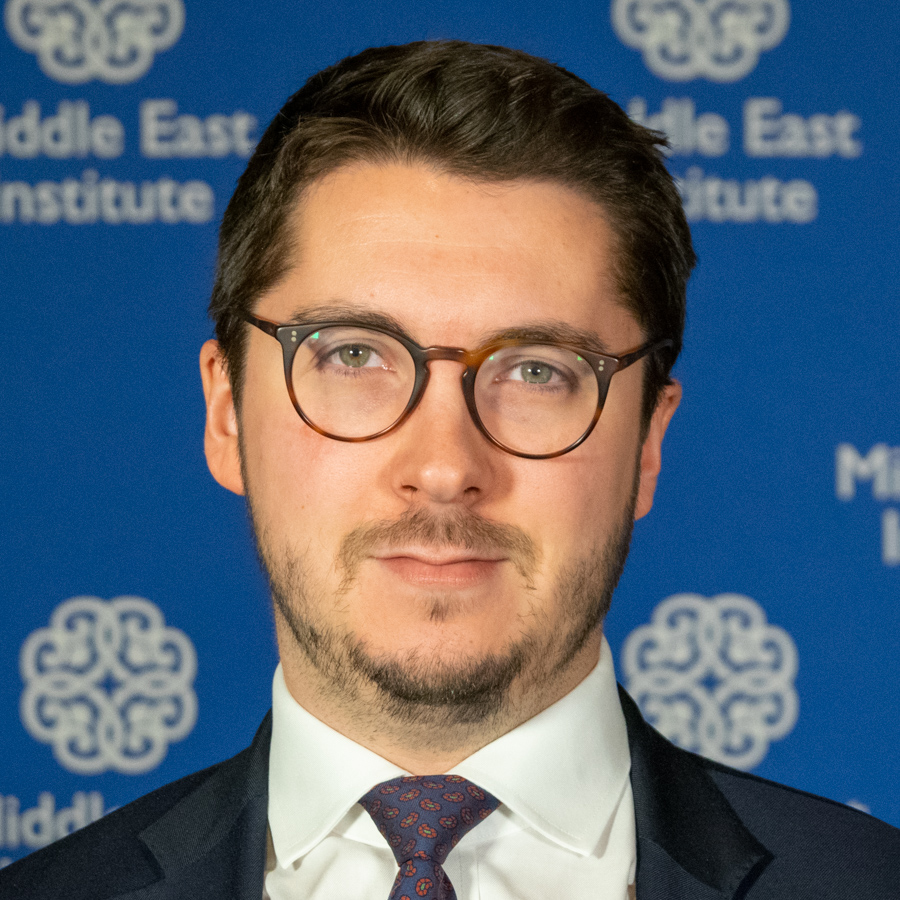
As we look ahead into 2022, the challenges and threats posed by terrorism do not look likely to register as high on the agendas of governments in the Middle East as they have in recent years. From regional diplomatic shifts and great power competition, to economic development and nuclear proliferation, attention is clearly being focused in other directions. While this pivot away from counterterrorism and countering violent extremism may be partly explained by recent successes in the region, it would be naïve to think the struggle is over.
More than any other development, the hasty U.S. withdrawal from Afghanistan and the Taliban’s resulting takeover has created a near-perfect recipe for a surge in local, regional, and possibly even global terrorism. On the one hand, the Taliban’s deep historical and familial ties to al-Qaeda and associated regional terrorist groups have offered them an invaluable opportunity for a quiet return to an Afghan safe-haven; on the other, ISIS has thrived in recent months, expanding its reach from a handful of Afghan provinces in mid-2021 to more than 35 by the turn of the year. And contrary to President Joe Biden’s claims, an “over-the-horizon” counterterrorism posture appears far from sufficient to detect and counter any threats that develop over time.
Beyond Afghanistan, not only did ISIS expand markedly across additional parts of Africa in 2021, but its global operations remained largely the same as in 2020, although more than 50% of its attacks were in Syria and Iraq. It is there, in its original heartlands, that ISIS remains engaged in a slow but methodical recovery, launching increasingly deadly and sophisticated attacks against forces aligned with the Syrian regime, Iran, Russia, the Syrian Democratic Forces (SDF), the Syrian opposition, the Iraqi government, and the Kurdistan Regional Government (KRG). With international attention waning, opportunities for ISIS to further its recovery in Syria and Iraq are visibly increasing.
While al-Qaeda’s central leadership remains quiet, its affiliates and associated groups continue to play significant roles in conflicts and areas of instability across the region. In the Sahel, Jamaat Nasr al-Islam wal Muslimin (JNIM) appears poised to play a role in rumored peace talks and in northwestern Syria, former affiliate Hayat Tahrir al-Sham (HTS) has become a de facto governing entity. The increasingly visible adaptation and flexibility of al-Qaeda affiliates speaks to a wider trend that looks set to sustain itself — and to which governments of all stripes appear to have no meaningful answer.
Meanwhile, Iran-backed militant proxies in Yemen, Iraq, Syria, Lebanon, and elsewhere appear to pose the greatest threat of terrorist attacks and political instability in 2022. A flurry of rocket and drone attacks on U.S. bases in Syria and Iraq; continued ballistic missile and drone attacks on Saudi Arabia; and a dramatic loitering munition and missile attack on the UAE in January 2022 all speak to the scope and unchallenged scale of the threat. More than 400 such attacks targeted Saudi Arabia in 2021 alone, and Iran’s continuing proliferation of unmanned aerial vehicle (UAV), rocket, and missile technology to partners across the region augurs poorly for what 2022 is likely to bring — with or without a nuclear accord.
Follow on Twitter: @Charles_Lister
A deal with Iran seems likely, but don’t expect a “grand bargain” or any fundamental changes
Alex Vatanka
Director of Iran Program and Senior Fellow, Frontier Europe Initiative

No one in Iran doubts that a positive outcome from the nuclear talks in Vienna will have a major impact on the country’s ailing economy. Still, the senior leadership in Tehran maintains that it will not let economic problems force it to reach a substandard deal with the Americans. This in practice likely means that 2022 will see Iran and the world powers revive the 2015 nuclear deal, or something similar to it, but this will not lead to a “grand bargain” in which Tehran will make concessions in non-nuclear areas such as its regional actions or ballistic missile program.
There is certainly no sign that Supreme Leader Ayatollah Ali Khamenei is paving the way for a deeper process of détente with Washington. Khamenei wants some of the most painful sanctions lifted in return for a smaller and internationally monitored Iranian nuclear program. He is seemingly calculating that the U.S. will slowly depart from the Middle East, leaving regional actors such as Iran to compete among themselves, and he wagers Tehran will do well in such a scenario. Khamenei, and the generals of the Islamic Revolutionary Guard Corps (IRGC), will hence spur the U.S. in this direction, but without wanting to risk a full-on confrontation with the Americans in the process. In this risky strategy, Khamenei believes time is on Iran’s side.
But even a new nuclear deal, and the prospect of a smaller U.S. footprint in the Middle East, will not lessen Tehran’s multiple challenges in the region. The flipside of Tehran having a freer hand to pursue its regional agenda is an Iran that overreaches and drains its finite resources on open-ended foreign adventures. From Lebanon and Syria to Iraq and Yemen, the cost of Iran’s interventions will remain a sore point in 2022. Khamenei and the IRGC’s top brass already face stiff popular anger in Tehran for pursuing a foreign policy agenda where the cost-benefit equation only makes sense from an Islamist ideological perspective and not from the point of view of advancing Iranian national interests.
Khamenei’s militant Islamist agenda is most determined around Tehran’s opposition to Israel’s right to exist. It is an ideological choice that Khamenei will not relinquish and is meant to be the glue that holds Tehran’s “Axis of Resistance” together. While Iranian officials are clearly annoyed by Israeli threats of military action against Iran’s nuclear installations, Tehran does not seem to take the idea of Israeli military action seriously. As the Israelis threaten to hit Iran, officials in Tehran largely believe that these are pressure tactics and that Jerusalem would not risk a wider war with Iran and its Arab proxies like Hezbollah by attacking Iran’s nuclear installations. Iran might misread the Israelis, but it shows little sign of anticipating a military conflict in the short term.
In short, in the Middle East of 2022 where countries such as Turkey, Saudi Arabia, and the UAE are all likely to rethink their foreign policy choices — and give more emphasis to economic development at home over costly zero-sum-game regional gambits — Khamenei and the IRGC are more likely to be the exception. The Islamist ruling elite in Tehran will make tactical compromises — with the Americans over the nuclear issue and as necessary with regional rivals such as the Saudis — but there is little sign to suggest that Tehran is ready to rethink the fundamental ideological drivers that have shaped Iranian foreign policy since 1979.
Follow on Twitter: @AlexVatanka
Global geopolitical competition and the Middle East
US-GCC relations: Clients or partners?
Gerald M. Feierstein
Senior Vice President
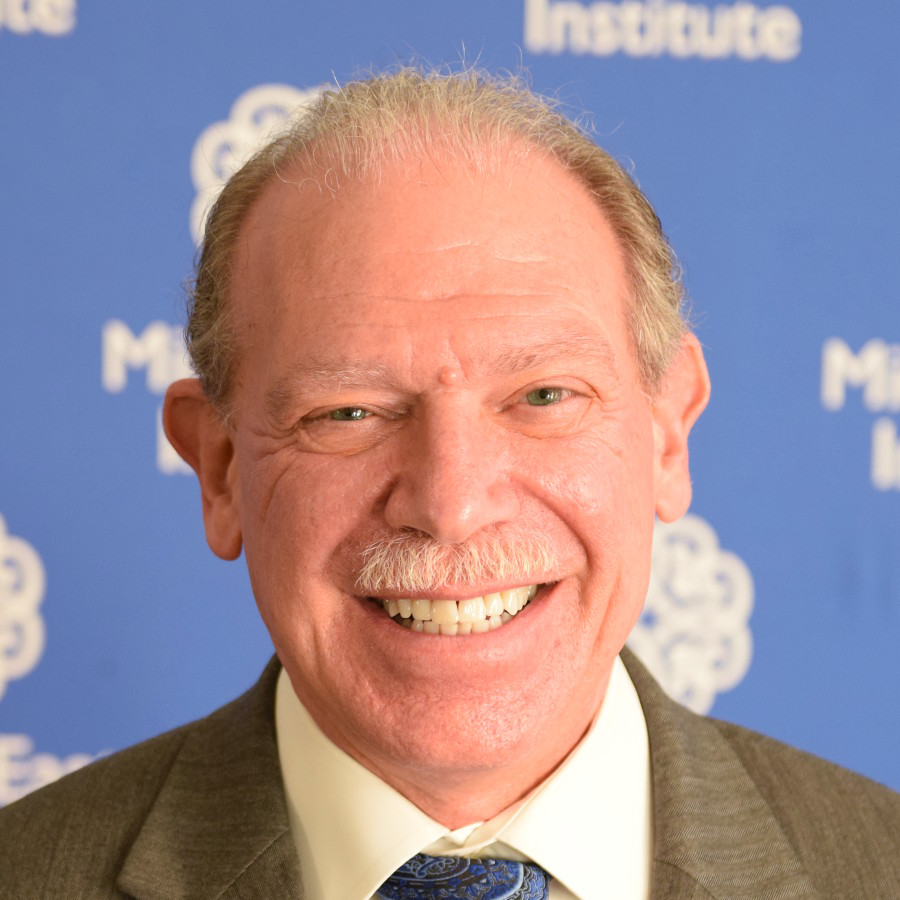
Thirty years have passed since Desert Storm and the high water mark of U.S.-Gulf Cooperation Council (GCC) collaboration. As a new generation moves more broadly into senior leadership positions in the region, some with little or no memory of the events of 1990-91, the rationale for continued acceptance of U.S. diplomatic and security preeminence has become less compelling. At the same time, the growing engagement by Gulf governments in international political, economic, and diplomatic affairs has brought to the fore new or expanded relations with a broad range of global partners. The assumption on Jan. 1 by the UAE of a non-permanent seat on the U.N. Security Council is only an example of the region’s growing global engagement. Thus, looking at U.S. relations in the region primarily through the lens of strategic competition with global rivals in Beijing or Moscow is an unhelpful and inaccurate framework.
The major regional powers, Saudi Arabia and the UAE, have pursued a strategic policy shift for several years. Based on a growing belief in their own capacity to define and pursue their national security and foreign policy goals and objectives, the two have turned the page on the past decades and determined to emphasize conflict resolution or, at least, mitigation as their main regional policy thrust. Beyond tension reduction, an additional advantage of their shifting policy direction is that it has reduced intra-GCC friction and brought their policies into closer alignment with their regional partners. This new direction is likely to persist in the future as it parallels an equivalent interest in focusing on domestic challenges arising from a changing global economic and energy environment, demographic trends, and recovery from the pandemic.
But the changing priorities will also have an impact on U.S. regional engagement, as the U.S. will no longer necessarily be the dominant or even the best-positioned partner in meeting the new goals. On economic growth and development, other potential partners in Europe, Asia, or elsewhere may be more attractive than a U.S. that has already ceded its position as the region’s number one trading partner. Even in the security arena, recent reporting regarding Saudi-Chinese cooperation on ballistic missile programs, suggestions that the Chinese are interested in establishing a military foothold in the UAE, and warnings that the Emiratis are prepared to walk away from negotiations on an F-35 purchase all suggest that reliance on the U.S. security umbrella may become a thing of the past.
The changing policy environment in the region is not necessarily a challenge for the U.S. In fact, several of the new directions of regional policy are consistent with, and even responsive to, shifting U.S. priorities. Nevertheless, the U.S. will retain substantial interest in managing these changes so that the full effect is not detrimental to broad U.S. goals and objectives. To succeed, the U.S. will need to adjust its approach to coordination with the Gulf states. In particular, the administration will need to forge real partnerships with the GCC states, including them in the policy development and decision-making process rather than assuming that they will fall in line with U.S. policy preferences. It is clear that regional leaders will insist that U.S. initiatives take into account their own priorities and preferences. One place to start in 2022 is to ensure that the U.S. has presidentially-appointed and Senate-confirmed ambassadors in place in all of the GCC capitals. U.S. failure to send ambassadors to these critical postings is often identified by regional leaders as a clear indication of a lack of U.S. attention or interest in the region.
Horn of Africa conflicts exacerbated by regional and great power competition
David H. Shinn
Non-resident Scholar
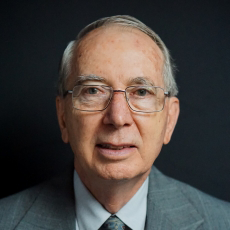
The Horn of Africa experienced a difficult 2021 and promises to endure an equally if not more challenging 2022. The civil war in Ethiopia currently involves less geography than it did a few months ago but is far from reaching a solution. Street protests continue in Sudan as the political crisis between the generals and civilian protesters worsens. Al-Shabaab remains a serious threat in Somalia as controversial parliamentary elections are again rescheduled. South Sudan faces one of the world’s most severe humanitarian crises, which shows signs of worsening.
All these conflicts could be ameliorated if there were agreement on solutions by the key international and regional actors. Unfortunately, this is not the case for any of the crises. Western countries, on the one hand, and China, Russia, and India, on the other, have different approaches to Ethiopia and Sudan. Key regional actors — Egypt, Turkey, Iran, and several of the Gulf states — are pursuing different policies on all of them. Eritrea has an outsized role in Ethiopia. Even Israel is something of a wild card in Sudan.
Ethiopia poses the biggest challenge for the United States. Neither the central government nor the rebel Tigrayan forces have demonstrated a willingness to end the military confrontation. The United States and the European Union will continue to push for a cease-fire and dialogue between the central government and Tigrayans. They will also urge unfettered humanitarian access to Tigray and an end to air strikes on civilian targets, and they are prepared to increase sanctions against all parties to the conflict. China, Russia, and India will continue to oppose sanctions and all three countries are more willing to accept the central government’s interpretation of events. Turkey, Iran, Saudi Arabia, and the UAE will continue to support the central government. Continuing conflict in Ethiopia offers an opening for Egypt to improve its bargaining position concerning the Grand Ethiopian Renaissance Dam (GERD) and may even result in support for the Tigrayan rebels. Eritrea, which sent troops into Tigray in support of the central government early in the conflict, will now pursue a low profile.
As differences increase between Sudan’s generals and civilian protesters, there is no prospect of ending the conflict. The military’s promise of elections in 2023 has fallen on deaf ears because it is not credible. In addition, the national military’s approach to the crisis is different than that of the allied Rapid Support Forces (RSF). The United States, which has had no ambassador in Khartoum since 1997, and its Western allies will continue to support the goals of the civilian protesters while China, Russia, and Egypt are aligned with the national military. The UAE and Saudi Arabia will remain close to both the national military and the RSF, which provided them troops in the Yemen conflict. Israel will continue to do what is required to ensure recognition by Sudan. The domestic political crisis will weaken Khartoum’s hand in countering Ethiopia on the GERD dispute.
Somalia’s prime minister has yet again rescheduled elections in the Lower House of Parliament, to be held by February 25, that will permit the selection of a new president. The fear is there will be another postponement, more tension between the prime minister and president, additional political instability in Somalia, greater opportunity for al-Shabaab to take advantage, and new reasons for several of the regional actors to interfere in Somali politics.
A third of South Sudan’s population is internally displaced and the 2018 peace agreement could be undermined by stalled implementation, risking a return to large-scale violence. The United States is the largest humanitarian donor, but its policy continues to be hindered by the lack of an ambassador. The major concern is that South Sudan will not receive adequate international attention because of a preoccupation with other crises in the Horn.
Follow on Twitter: @AmbShinn
Will China be able to sustain its momentum in MENA in 2022?
John Calabrese
Director, Middle East-Asia Project

Last year can hardly be regarded as a banner year for China or for President Xi Jinping — though the official narratives of the party-state will no doubt have portrayed it as such. Indeed, 2021 was marked by political crackdowns on Hong Kong and Xinjiang, “zero-tolerance” lockdowns in provinces experiencing fresh COVID outbreaks, high-tech corporate shakedowns, an economic slowdown that sank to a level not seen for three decades, and a continuing relationship meltdown with the United States.
2022 is shaping up to be a year of big moments for China — bracketed by the hosting of the Beijing Winter Olympics in February and the holding of the 20thChinese Communist Party (CCP) National Congress in November. It is also shaping up to be a year of big stakes for China — as the country braces for the arrival of Omicron, struggles to avert the bursting of its speculative real estate “bubble,” and steels itself for the next round of great-power competition.
As it grapples with these and other challenges, can China sustain the momentum of its extensive penetration of MENA economies in pursuit of the ambitious aims of the Belt and Road Initiative (BRI)?
Energy interdependence and maritime trade form the backbone of Sino-Mideast ties. These are structural features that even an accelerated global decarbonization timetable cannot fundamentally change. But in recent years, quite a lot has changed: State-owned and private firms have succeeded in planting the flag and establishing logistics bases in the Gulf and Egypt from which to advance Chinese commercial and strategic interests across and beyond the MENA region. And lately in its relations with BRI partners in the Mideast and elsewhere, China has begun to pivot away from involvement in physical infrastructure and toward information and digital infrastructure.
The BRI infrastructure ecosystem is evolving, not crumbling. And while Mideast partners remain keen to participate in the BRI, Washington appears ever more wary of its strategic implications and determined to counter it.
Possible convergence of trends
Steven Kenney
Director, Strategic Foresight Initiative
Ross Harrison
Senior Fellow and Director of Research
When looking at the year ahead in the Middle East, the negative trends tend to outnumber or outweigh the positive ones. The negative factors may have an outsized impact on the convergences we see and on their consequences, reinforcing the pessimistic bias of many analysts of this tumultuous region. There are at least two paths this could take.It’s one thing, and an important one, to consider how trends might take shape in the MENA region in 2022 and beyond. But a common pitfall in doing so is looking at trends in isolation. It’s equally important to consider how different types of trends could converge, influencing one another, sometimes creating new trendlines. Such convergences often spur opportunities and risks that are not envisioned, but perhaps with proper analysis could be anticipated.
One is where we might see two (or more) negative trends converging to reinforce one another. Systemic trends bedeviling the region such as rising temperatures, food insecurity, and public health crises could go from coexisting to exacerbating one another’s harmful effects. If we think of trends as vectors — having both direction and magnitude — an increasing magnitude of any or all three of these troubling trends could shift their combined force in a new direction, toward widespread humanitarian crises. That in turn could intersect with and accelerate the man-made trend of a deepening authoritarianism in the region. As the legitimacy of governments is challenged by an inability to respond to dire human security threats, more leaders may tighten the lid on societies they fear might spin out of control.
A second path to consider is how positive trends might be overwhelmed by the negative ones. For example, the trend we see in the Gulf Arab states of leaders pushing for economic, social, and political change has the potential to be a positive development for 2022. Linked to this is the prospect of the current trend toward de-escalation of tensions between Saudi Arabia and Iran, which if it continues holds the promise of more robust diplomatic activity.
But there is a risk of the vectors of these positive trends being overwhelmed by more powerful negative trends in the countries of the region that are mired in conflict and dysfunction. Those in various stages of civil war, namely Syria, Yemen, and Libya, and those with weakened governance systems like Iraq and Lebanon, could continue to draw in the more powerful regional actors, such as Saudi Arabia, Iran, and Turkey. This could hamper diplomatic progress between these countries and make it difficult for leaders in Saudi Arabia and the UAE to keep their reform ambitions on their current trendlines.
The reason for this is that conflict patterns (and other destructive trends) often are more “contagious” than economic and social reform patterns. The civil wars in the region quickly spread from country to country, but also upward to exacerbate the hostilities between the regional powers. Without regional institutions to help foster positive economic and social change across MENA, the more negative factors tend to spread in the vacuum. The emergence of vibrant regional institutions could help offset some of the risks of negative contagion trends converging with and suffocating trends of economic and social reform. But a move toward a regional institutional architecture is unlikely to gain traction in the Middle East in 2022.
At the same time, it is important to also think about converging trends from the other perspective — the one that sees positive trends converging with one another to create more virtuous changes in vector.
One of the positive trends over the last few years, and one we expect to see continuing to advance in 2022, is increasing openness to taking action on climate change and support for an energy transition in the region and globally. The UAE in particular is framing climate action as an opportunity that can create jobs and drive economic growth, and they are not alone in this view in the region. The magnitude of the view is growing in part because of the parallel growth in the power and influence of the new generation of leaders pushing for reforms on multiple fronts in their countries.
The impact of this convergence could have further positive ripple effects on other trends. Another recent trend likely to accelerate in 2022 and beyond is rising economic competition among the regional powers, particularly between Saudi Arabia and the UAE. Some see this competition as an impending collision course, while others recognize there are reasons to be more optimistic, on the theory that a rising tide lifts all boats. One dimension of that competition may be a race to build the industries of the green economy, bringing together the imperatives of climate change adaptation and economic growth in a mutually supportive direction that boosts the magnitude of both.
What leaders in the region and the international community must do, in 2022 and every year, and as a matter of course, is invest the time to consider these kinds of convergences proactively. It’s in the forethought that new opportunities can be seen and shaped, and actions to mitigate risks can be prepared. The fact is that no trend progresses in isolation. They all have intersections with many others that just have not yet happened.
Photo by Yassine Gaidi/Anadolu Agency via Getty Images












